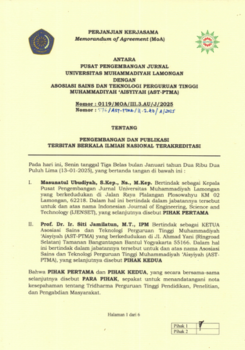THE RELATIONSHIP BETWEEN WAVE PROPAGATION SPEED AND TENSION OF BOUND END STATIONARY WAVES
DOI:
https://doi.org/10.38040/ijenset.v1i1.826Abstract
Waves are vibrations that move energy from one place to another without being aware of what passes through them. The waves observed in this experiment are mechanical waves, namely standing waves on a rope. The purpose of this experiment is to determine the size of the wave length on the rope, the relationship between the speed of propagation and the tension in the rope, and the factors that affect the speed of waves on the rope. The tools and materials used in this experiment were a 220 Volt AC vibration source, ropes, weights, fixed pulleys, balances, and rulers. In this experiment, we use a frequency value of 11.61 Hz, a period of 0.08 seconds, and three weight variations of 0.02 kg, 0.024 kg and 0.05 kg respectively. After that, the value of the rope tension has also been obtained, each of which has changed, namely 0.2 kg.m/s2, 0.24 kg.m/s2, and 0.5 kg.m/s2. While the values of the speed of propagation are 0.0361 m/s, 0.0441 m/s, and 0.09 m/s. So, the experimental results show that the greater the mass of the load used in this experiment, the greater the wavelength. This causes the wave propagation speed and rope tension to increase. Thus, the speed of wave propagation is directly proportional to the tension in the rope. Then the size of the stationary wavelength on the rope (λ) is 0.53 m. In addition, from this experiment we can find out the factors that affect the speed of wave propagation on the rope, namely the rope tension (F) and the mass density of the rope (µ).
References
Z. J. Hadi, N. Amrullah, and A. A. Zhafransyah, “The Analysis of Melde Tool as Learning Media on Students Senior High School,” Pancar. Pendidik., vol. 10, no. 1, pp. 23–30, 2020, doi: 10.25037/pancaran.v9i4.311.
Septi Budi Sartika and Noly Shofiyah, “Psychomotor Skills of Pre-service Teachers of Natural Science on Melde’s Experiment in Guided Inquiry Learning,” IJORER Int. J. Recent Educ. Res., vol. 1, no. 2, pp. 108–115, 2020, doi: 10.46245/ijorer.v1i2.32.
H. Pain, The Physics of Vibrations and Waves 6th ed, 6th ed. London, UK: John Wiley and Sons Ltd, 2005.
P. K. Pertiwi, Y. F, N. L. Isnaini, and Zainuri, “Percobaan Melde,” J. Pratikum Gelombang, no. 5, pp. 1–8, 2016.
W. Widayanti, Y. Yuberti, I. Irwandani, and A. Hamid, “Pengembangan Lembar Kerja Praktikum Percobaan Melde Berbasis Project Based Learning,” J. Pendidik. Sains Indones., vol. 6, no. 1, pp. 24–31, 2018, doi: 10.24815/jpsi.v6i1.10908.
A. K. Umam, R. W. Utami, A. H. Putri, A. Syaharani, and G. Antarnusa, “Pengaruh Rapat Massa Tali terhadap Cepat Rambat Gelom-bang Pada Percobaan Hukum Melde Prosiding Seminar Nasional Pendidikan Fisika Untirta,” Pros. Semin. Nas. Pendidik. Fis., vol. 3, no. 1, pp. 348–354, 2020, [Online]. Available: https://jurnal.untirta.ac.id/index.php/sendikfi/.
M. G. Nugraha, S. Utari, D. Saepuzaman, and F. Nugraha, “Redesign of students’ worksheet on basic physics experiment based on students’ scientific process skills analysis in Melde’s law,” J. Phys. Conf. Ser., vol. 1013, no. 1, 2018, doi: 10.1088/1742-6596/1013/1/012038.
D. Halliday, R. Resnick, and J. Walker, “Fundametals of Physics,” pp. 1–1334, 2008.
Young and Freedman, “University Phisics 12th Edition.” pp. 150–152, 2008.
R. A. Shavira and D. Fisika, “RHEINA AURELY SHAVIRA-01111640000083-Hukum Melde 1.”
M. G. Nugraha, S. Utari, D. Saepuzaman, F. N. Solihat, and K. H. Kirana, “Development of basic physics experiments based on science process skills (SPS) to enhance mastery concepts of physics pre-service teachers in Melde’s law,” J. Phys. Conf. Ser., vol. 1280, no. 5, 2019, doi: 10.1088/1742-6596/1280/5/052075.
Downloads
Published
Issue
Section
Citation Check
License
Authors who publish with this journal agree to the following terms:
- Authors retain copyright and grant the journal the right of first publication with the work simultaneously licensed under a Creative Commons Attribution License that allows others to share the work with an acknowledgment of the work's authorship and initial publication in this journal.
- Authors are permitted and encouraged to post their work online (e.g., in institutional repositories or on their website) prior to and during the submission process, as it can lead to productive exchanges, as well as earlier and greater citation of published work (See the Effect of Open Access).
- IJENSET journal by LPPM-UMLA is licensed under a Creative Commons Attribution-ShareAlike 4.0 International License.










